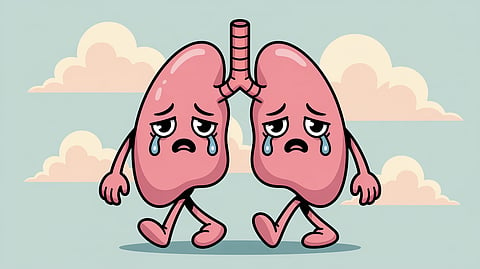

It usually starts like a cold. A stuffy nose. A mild cough. Maybe even a fever. You think you’ll get better with some rest and soup. But then the cough gets worse. Breathing becomes harder. Your chest feels like it’s carrying bricks. And before you realise it, you’re not just unwell — your lungs are in trouble. This is pneumonia, and it doesn’t always shout when it arrives.
The word pneumonia comes from the ancient Greek word for “lungs,” which tells you exactly where this illness strikes. It’s an infection that inflames the air sacs in one or both lungs. These tiny sacs, called alveoli, are normally filled with air and help you breathe in oxygen and breathe out carbon dioxide. But when pneumonia hits, they fill up with pus or fluid, making it hard to breathe.
There’s not just one cause of pneumonia. It can be triggered by bacteria, viruses, fungi, or even tiny organisms called mycoplasma. The most common type is bacterial pneumonia, often caused by a bacterium called Streptococcus pneumoniae. Then there’s viral pneumonia, which can be caused by the flu or even Covid-19. In many developing countries, it’s still one of the biggest killers of children under five — even though it’s treatable and, in many cases, preventable.
Not all cases look the same. Some people get high fevers, others just feel tired and short of breath. In young children and the elderly, the signs may be so subtle that they’re easily missed. That’s what makes pneumonia so sneaky — it hides behind symptoms that could be anything from a bad flu to asthma. But one thing is usually the same: it drains your body’s energy, and your lungs start working overtime.
Doctors usually listen to your chest with a stethoscope to check for crackling or rattling sounds. Sometimes they order a chest X-ray to confirm the diagnosis, and if it’s bacterial, they prescribe antibiotics. For viral pneumonia, you mostly need rest, fluids, and fever control. Severe cases may need hospital care, especially if oxygen levels drop. And if someone already has a weak immune system — like very young children, older adults, or people with chronic illness — pneumonia can turn dangerous quickly.
But here’s the good news: pneumonia can often be prevented. There are vaccines, like the pneumococcal vaccine and the flu shot, that protect against the most common causes. Washing hands regularly, staying away from people who are sick, and eating nutritious food to boost your immunity — all of these play a role in keeping pneumonia away. When Alexander Fleming discovered penicillin in 1928, it revolutionised pneumonia treatment. Before that, pneumonia was one of the leading causes of death in the Western world.
In history, pneumonia was once called “the old man’s friend” because it often claimed lives quietly in the elderly. But modern medicine has changed that story. Today, it’s less about fate and more about awareness and action.